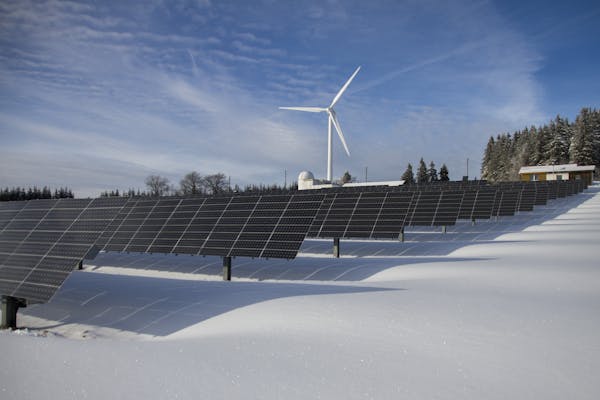
As the global demand for energy continues to rise, the need for sustainable and environmentally friendly energy solutions has become more critical than ever. Green energy technologies, often referred to as renewable energy technologies, are at the forefront of this transition. These technologies harness natural resources such as sunlight, wind, water, and biomass to generate energy, offering a cleaner and more sustainable alternative to fossil fuels. In this article, we will delve into the various types of green energy technologies, their benefits, challenges, and the future prospects of these revolutionary energy solutions.
Types of Green Energy Technologies
Solar Energy
Solar energy is one of the most widely recognized and utilized forms of green energy. It involves the conversion of sunlight into electricity using photovoltaic (PV) cells or solar thermal systems.
- Photovoltaic (PV) Systems: PV systems use solar panels made of semiconductor materials like silicon to convert sunlight directly into electricity. These panels can be installed on rooftops, in solar farms, or integrated into building materials.
- Solar Thermal Systems: Solar thermal systems capture and concentrate sunlight to produce heat, which can be used to generate electricity or for heating purposes. Examples include solar water heaters and concentrated solar power (CSP) plants.
Wind Energy
Wind energy harnesses the power of wind to generate electricity. Wind turbines, often grouped in wind farms, convert the kinetic energy of wind into mechanical power, which is then transformed into electricity.
- Onshore Wind Farms: These are wind farms located on land, typically in areas with strong and consistent wind patterns.
- Offshore Wind Farms: Located in bodies of water, offshore wind farms benefit from stronger and more consistent winds than their onshore counterparts.
Hydropower
Hydropower generates electricity by using the energy of flowing or falling water. It is one of the oldest and most reliable forms of green energy.
- Large Hydropower Plants: These plants typically involve the construction of dams on large rivers. The water stored in the dam is released to drive turbines that generate electricity.
- Small Hydropower Plants: Small-scale hydropower plants use the natural flow of rivers and streams to generate electricity, often without the need for large dams.
- Run-of-the-River Systems: These systems divert a portion of river flow through a canal or penstock to drive turbines, minimizing the environmental impact compared to large dams.
Biomass Energy
Biomass energy involves the use of organic materials such as wood, agricultural residues, and animal waste to produce electricity, heat, or biofuels.
- Biomass Power Plants: These plants burn biomass materials to produce steam, which drives turbines to generate electricity.
- Biofuels: Biomass can be converted into liquid fuels such as ethanol and biodiesel, which can be used in transportation.
Geothermal Energy
Geothermal energy harnesses the heat from the Earth’s interior to generate electricity or provide direct heating.
- Geothermal Power Plants: These plants use steam or hot water from geothermal reservoirs to drive turbines and generate electricity.
- Geothermal Heating Systems: These systems use the stable temperatures beneath the Earth’s surface to provide heating and cooling for buildings.
Ocean Energy
Ocean energy includes various technologies that harness the power of the ocean to generate electricity.
- Tidal Energy: Tidal energy systems capture the energy from the rise and fall of tides to generate electricity.
- Wave Energy: Wave energy devices convert the kinetic energy of ocean waves into electricity.
- Ocean Thermal Energy Conversion (OTEC): OTEC systems use the temperature difference between warm surface water and cold deep water to generate electricity.
Benefits of Green Energy Technologies
Environmental Benefits
- Reduction in Greenhouse Gas Emissions: Green energy technologies produce little to no greenhouse gases, helping to mitigate climate change and reduce air pollution.
- Conservation of Natural Resources: By utilizing renewable resources, green energy technologies help preserve finite natural resources such as coal, oil, and natural gas.
- Reduction of Water Usage: Many green energy technologies, such as wind and solar power, require significantly less water than conventional power plants, reducing the strain on water resources.
Economic Benefits
- Job Creation: The renewable energy sector is a significant source of job creation, from manufacturing and installation to maintenance and research.
- Energy Independence: By investing in local renewable energy sources, countries can reduce their reliance on imported fossil fuels, enhancing energy security.
- Stable Energy Prices: Unlike fossil fuels, which are subject to price volatility, renewable energy sources offer more stable and predictable energy prices.
Social Benefits
- Improved Public Health: By reducing air and water pollution, green energy technologies contribute to better public health outcomes, reducing healthcare costs and improving quality of life.
- Rural Development: Renewable energy projects, especially wind and solar farms, can provide economic opportunities and infrastructure improvements in rural and remote areas.
Challenges Facing Green Energy Technologies
Intermittency and Reliability
- Variable Nature of Renewable Resources: Solar and wind energy are dependent on weather conditions and time of day, leading to intermittency issues. This requires the development of reliable energy storage solutions and grid management systems.
- Grid Integration: Integrating large amounts of renewable energy into existing power grids can be challenging due to the need for grid stability and balancing supply and demand.
High Initial Costs
- Capital Investment: The initial costs of installing renewable energy systems can be high, although they are offset by lower operational costs and long-term savings.
- Financing and Incentives: Access to financing and government incentives is crucial for the widespread adoption of green energy technologies. Policy support and favorable regulations can help attract investment and reduce financial barriers.
Land and Resource Use
- Land Requirements: Large-scale renewable energy projects, such as wind and solar farms, require significant land areas, which can lead to land-use conflicts and habitat disruption.
- Resource Availability: The availability of renewable resources, such as sunlight and wind, varies by location, influencing the suitability of different green energy technologies in different regions.
Technological and Infrastructure Development
- Research and Development: Continuous innovation and technological advancements are necessary to improve the efficiency and cost-effectiveness of green energy technologies.
- Infrastructure Upgrades: Upgrading and modernizing existing infrastructure, such as power grids and transmission lines, is essential to support the integration of renewable energy sources.
Future Prospects of Green Energy Technologies
Technological Advancements
- Energy Storage Solutions: Advancements in energy storage technologies, such as batteries and supercapacitors, are crucial for addressing the intermittency of renewable energy sources and ensuring a stable power supply.
- Smart Grids: The development of smart grids, which use digital technology to manage and optimize the distribution of electricity, can enhance the integration and efficiency of renewable energy sources.
- Advanced Materials: Innovations in materials science, such as more efficient photovoltaic materials and lightweight wind turbine blades, can improve the performance and cost-effectiveness of green energy technologies.
Policy and Regulatory Support
- Government Incentives: Continued government support through subsidies, tax credits, and grants can drive the adoption of renewable energy technologies and attract private investment.
- Renewable Energy Standards: Implementing renewable energy standards and targets can provide a clear framework for the transition to a sustainable energy future.
- Carbon Pricing: Implementing carbon pricing mechanisms, such as carbon taxes or cap-and-trade systems, can incentivize the reduction of greenhouse gas emissions and promote the adoption of green energy technologies.
Public Awareness and Education
- Raising Awareness: Educating the public about the benefits and importance of green energy technologies can foster widespread support and drive consumer demand.
- Community Engagement: Involving local communities in renewable energy projects can enhance acceptance and support, leading to successful project implementation.
Global Cooperation
- International Collaboration: Global cooperation and knowledge-sharing can accelerate the development and deployment of green energy technologies, addressing common challenges and leveraging collective expertise.
- Climate Agreements: International climate agreements, such as the Paris Agreement, play a crucial role in setting global targets for greenhouse gas reduction and promoting the adoption of renewable energy.
Conclusion
Green energy technologies represent a pivotal shift towards a sustainable and environmentally friendly energy future. By harnessing the power of natural resources such as sunlight, wind, water, and biomass, these technologies offer a cleaner and more sustainable alternative to fossil fuels. Despite the challenges of intermittency, high initial costs, and land use, the benefits of green energy technologies—such as reducing greenhouse gas emissions, creating jobs, and enhancing energy security—far outweigh the obstacles.
With continued technological advancements, policy support, and global cooperation, green energy technologies have the potential to revolutionize the energy landscape and pave the way for a more sustainable future. Embracing these technologies is not just an option but a necessity for ensuring the well-being of our planet and future generations.




